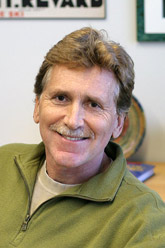
Handy Links
SLAC News Center
SLAC Today
- Subscribe
- Archives: Feb 2006-May 20, 2011
- Archives: May 23, 2011 and later
- Submit Feedback or Story Ideas
- About SLAC Today
SLAC News
Lab News
- Interactions
- Lightsources.org
- ILC NewsLine
- Int'l Science Grid This Week
- Fermilab Today
- Berkeley Lab News
- @brookhaven TODAY
- DOE Pulse
- CERN Courier
- DESY inForm
- US / LHC
SLAC Links
- Emergency
- Safety
- Policy Repository
- Site Entry Form

- Site Maps
- M & O Review
- Computing Status & Calendar
- SLAC Colloquium
- SLACspeak
- SLACspace
- SLAC Logo
- Café Menu
- Flea Market
- Web E-mail
- Marguerite Shuttle
- Discount Commuter Passes
-
Award Reporting Form
- SPIRES
- SciDoc
- Activity Groups
- Library
Stanford
Around the Bay
From the Director of LCLS: What is SXR?

It is 6:18 p.m. on Thursday night and I am getting a late start writing my SLAC Today column for tomorrow. I had planned to write it on LCLS-II because we just got the green light for this exciting project. I just decided, however, that this has to wait when I opened an e-mail sent at 4:43 p.m. which made me very, very happy. The e-mail signals the conclusion of a Cinderella story called SXR.
It officially started with a note I wrote on October 10, 2007 to John Galayda beginning with the sentence "This note serves to start a dialogue with Linac Coherent Light Source management to establish an MOU for use of hutch 1 for 'soft X-ray spectroscopy, scattering and imaging.'" The note reflected my interest as a scientist, shared by my SLAC colleagues Anders Nilsson and Z. X. Shen, to create a soft X-ray facility at LCLS with emphasis on the study of materials. The original roadmap document "LCLS – The first Experiments" written in the fall of 2000 had not envisioned such a soft X-ray facility because it focused on hard X-rays. Production of soft X-rays was mostly seen as a necessary step in commissioning LCLS which was thought to be easier at soft than hard X-ray energies, and for the study of atoms and molecules in gases as part of the Atomic, Molecular and Optical instrument. Instead, my colleagues and I were interested in using soft X-rays to study the electronic and magnetic structure of materials. Over the years we began to build the scientific case for such a facility on LCLS and it was in principle approved by the LCLS Scientific Advisory Committee. Problem was, there were funds only for four instruments for which construction was coordinated by LCLS/LUSI. So we had to think out of the box.
First we needed LCLS management’s approval for "outsiders" to design and construct a fifth instrument, hence the letter to John Galayda. Second, we needed to round up the money. After brainstorming with leading soft X-ray advocates from around the world, in particular with colleagues from the Advanced Light Source in Berkeley and the BESSY facility in Berlin, and also involving scientists from the ultraviolet free-electron laser FLASH in Hamburg we developed a daring plan to create such a facility with external funds and record speed. Half a year after my letter, in April 2008, we met in Hamburg to form the Soft X-Ray or SXR consortium with the goal of building an SXR instrument to catch some of the first X-rays of LCLS, at the time only about one and a half years away.
To make a long story short, we seeded the SXR project with dollars from the Stanford Dean of Research and Euros from the German Science Foundation, brokered by our DESY colleagues, and additional Euros from the Center for Free Electron Laser Science at DESY. With help and support from LCLS management, especially Jochen Schneider and John Galayda, and the involvement of two key people, Michael Rowen from SLAC and Phil Heimann from LBNL we managed to design and build SXR to become the second experiment ready for beam at LCLS.
So why did the 4:43 p.m. e-mail put a smile on my face? It was sent by Bill Schlotter and Josh Turner, the SXR instrument scientists, informing me of first beam into SXR and in the spirit of youth attaching an iPhone picture. Thank you all who helped pull this off.
